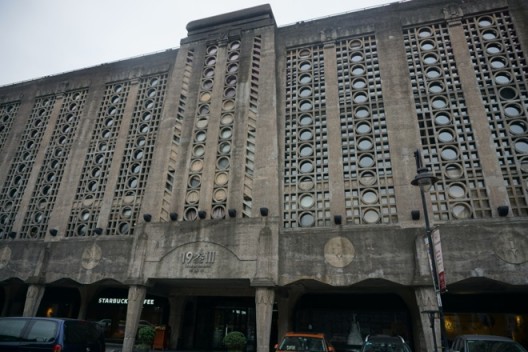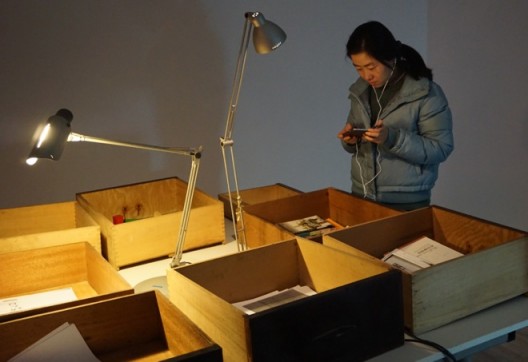“Chased After by Life”: Wu Meng’s Sound Theater
1933 Contemporary (No. 1, 1933 Shanghai, 611 Liyang Lu, Hongkou, Shanghai), Jan. 9, 16, and 17, 2016
First-time visitors are inevitably impressed by the wondrous labyrinthine architectural setup at 1933 Shanghai. Built in 1933, this former slaughterhouse under the Ministry of Industry in the former International Concession was built with the most modern materials at the time—steel and concrete—designed by the British architect A. Carr Wheeler, and constructed by the most acclaimed construction company in Shanghai, Yu Hong Ji Construction Company. Taking 13 years to complete, the high quality of construction was indeed rare. The complex corridors, partitions, umbrella columns, and staircases in the building not only established a utopian architectural aesthetics; the building’s rational, efficient functioning also rendered it an intricate piece of machinery.
In 2007, the entire structure was remodeled into a creative industry cluster, occupied by a variety of businesses: wedding photo studios, a cosplay photo studio, the China Ferrari Club, “escape room” games, fashion shows, a small theater, a contemporary art center—along with the selfie sticks and the young lovey-doveys traipsing on the paths trod by the cattle of yesteryear, gazing sincerely and yet emptily into the camera. Amid this enticing, almost irresistible journey back in time, where then is tangible life at hand?


Such was the question Wu Meng considered through sound when confronted with the former slaughterhouse that is 1933 Shanghai. “Chased After by Life” is a journey through a sound piece inspired by the unique historical heritage of the place as well as by the contemporary present. Putting on the earphones, one is guided by Wu Meng’s sounds—following her instructions, sympathizing with her memories, envisioning what she imagines. Adopting a poetic language in order to welcome listeners into her description and imagination of Shanghai, Wu Meng’s verse wanders among the antiques, memories, and the various floating imageries and pregnant moments. By adapting the soundtrack of the patriotic education film War in Shanghai—a Communist Party–representation of Shanghai’s liberation—along with old photos, correspondences, vintage suitcases, and the slum residents’ colorful plastic basins, placed under their tents on rainy days, Wu Meng brings the audience into a nostalgic setting. Narrative and imagination, reality and fiction—the presence of sound substitutes the actors’ movements and dialogue on stage. The actors’ dramatic flourishes under the spotlight and their soliloquies become Wu Meng’s murmurs in the ear. With Wu Meng’s sounds, you begin to wonder about the stairs and corridors of the old slaughterhouse, searching for the clues she has hidden in the concrete pillars and vaults, passing by details in the theatrical scenario and visitors in real life.
“Chased After by Life” is a drama that explores the interconnections between the city and its individuals. Wu Meng has broken down the Canadian artist Janet Cardiff’s interpretation of sound art into memories of the new Shanghainese, as well as into narratives of relocated residents in the shantytown that used to exist in the vicinity of the slaughterhouse. Life in these shantytowns has interested Wu Meng in recent years. These workers’ living spaces during the early days of Shanghai’s industrialization had narrow alleys where not even an umbrella could open, where a cramped makeshift tower housed an extended family of multiple generations. This was thus a projection of life and reality up close.
Wu Meng employs a first-person narrative to tell the story of the residents of the shantytown. For example, two married-off sisters lamented about not having their own beds: “Cooking, eating, clothes washing, playing Mahjong, braised pork, cleaver, green vegetables…” Wu Meng’s sound extracts details from the quotidian, imbuing an awkward reality with a certain romanticism. Perhaps this is a reminder to the listener of the ambiguous nature of the artwork—situated between reality and fiction—while her sound serves up an encounter with a migrant worker squatting behind the kitchen and playing on his mobile phone. Is he a part of the scenario? Is he a part of the life in the old slaughterhouse? Reality being one mere step away from fiction, the most wonderful art should be those odd and indecipherable moments wavering between reality and fiction.
“Chased After by Life” is a theatrical interpretation by means of textual materials; yet the most impressive part is still Wu Meng’s narrative rather than the interrelation between the on-site sounds and the narrative. As the slaughterhouse of yesteryear embodies a nation from revolution through to economic reforms, all we can do, perhaps, is to listen to the hushed silence of the building itself.



